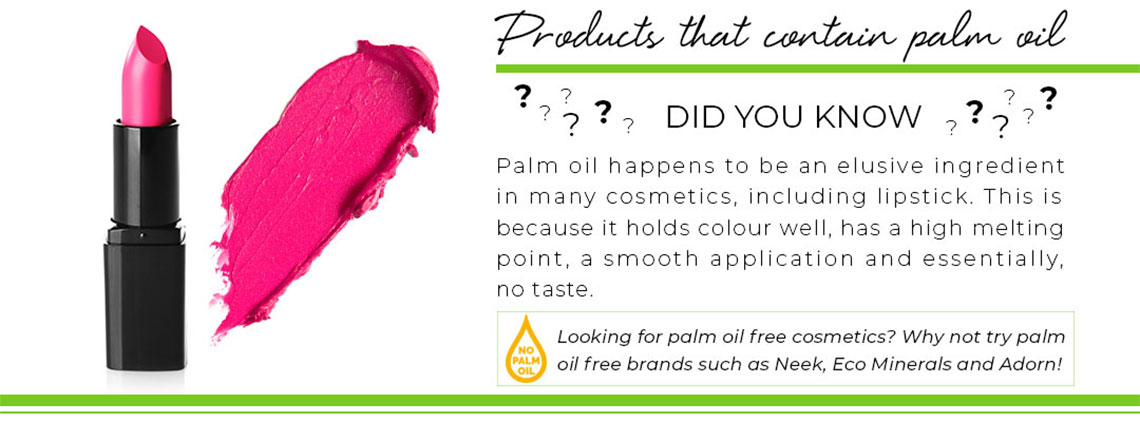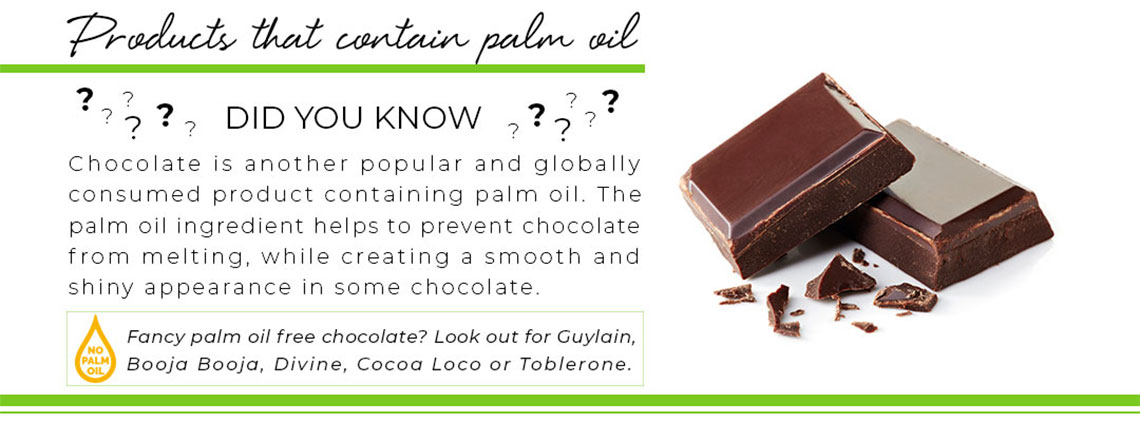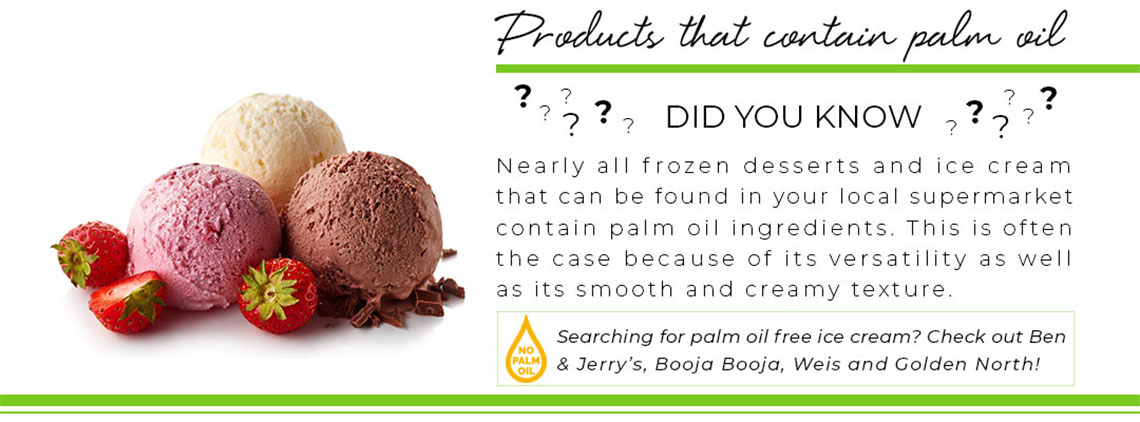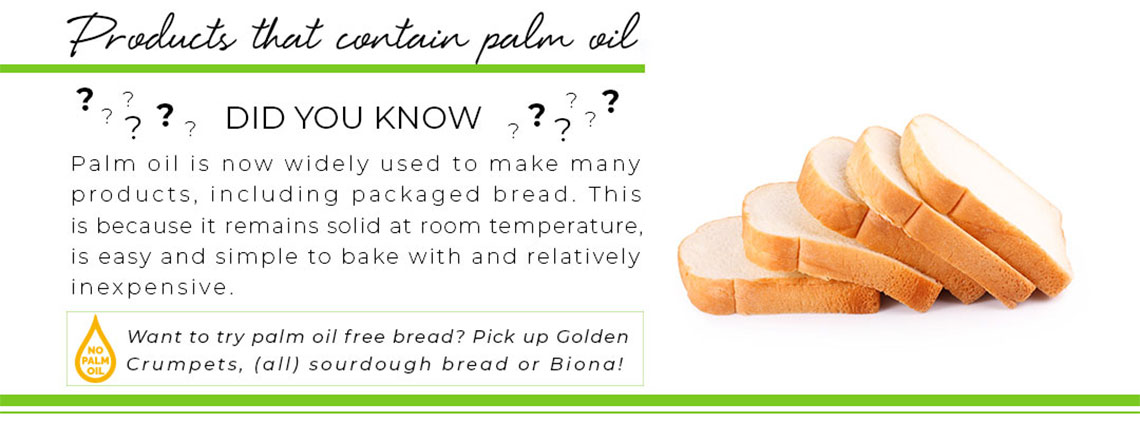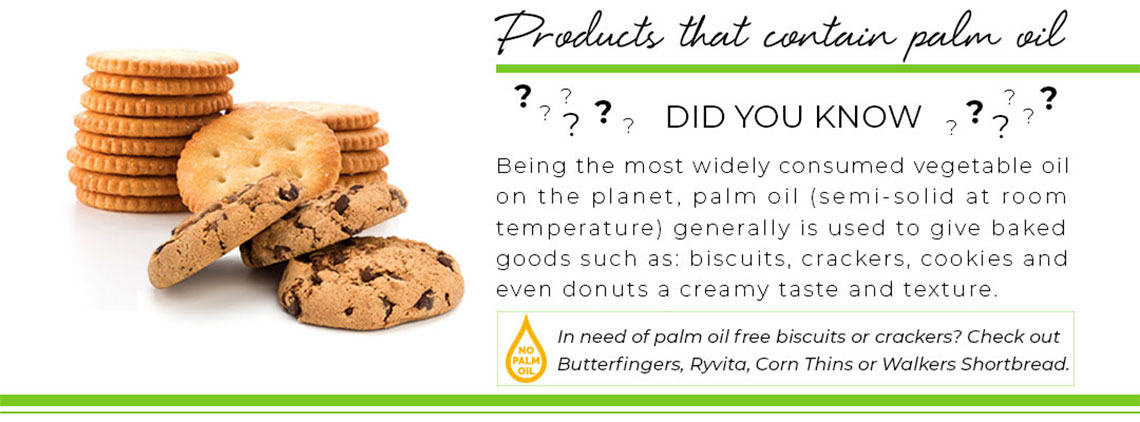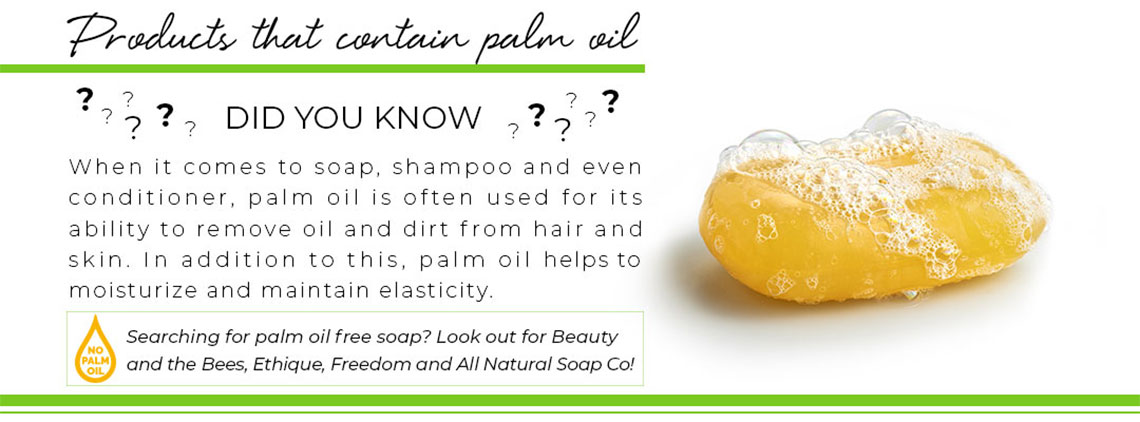Palm Oil: A Dark Future For Orangutans
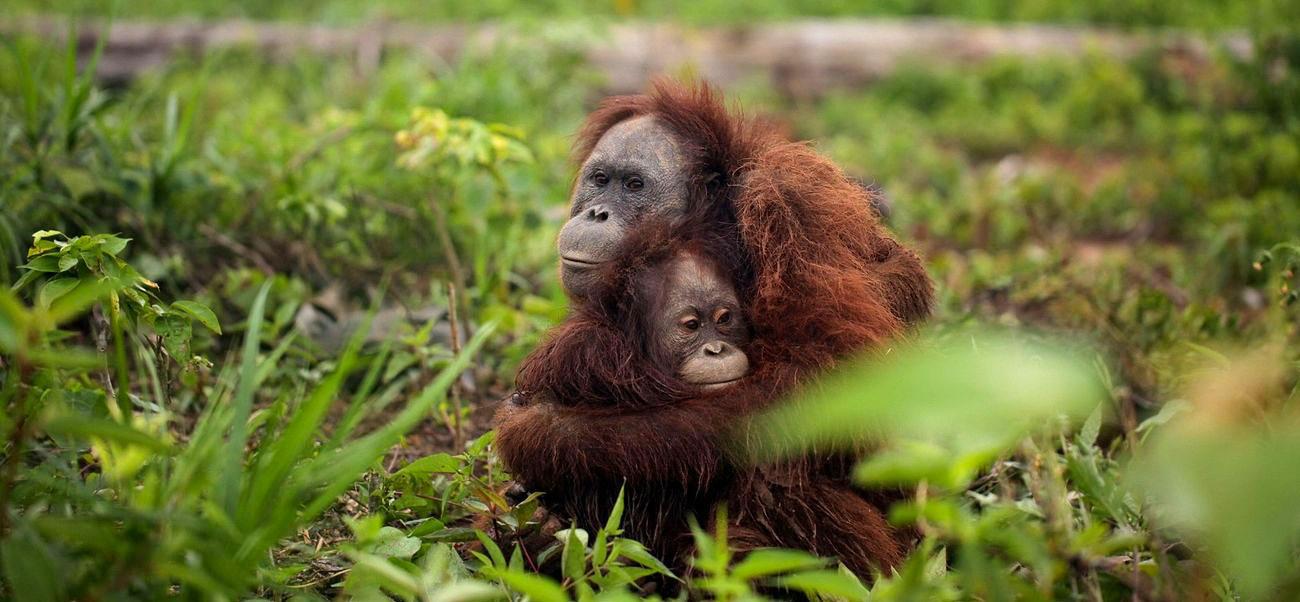
For something that is so widely and generously used by people all over the world (yes, we mean you too), you would expect palm oil to be a good thing, right? Think again...Yes, people use palm oil every day - some without even realising - and although few have heard about it, many still do not know the truth about palm oil. We're talking about what really happens behind the scenes in palm oil production and the dark side to this edible commodity. So, we ask you: have you ever considered the negative effects of the palm oil industry, such as its impact on both animal populations and the environment? Does this mean palm oil is causing more harm than good?
As we delve into the hard facts about palm oil, we'll explain why it is imperative to act now and answer some of the most commonly asked questions regarding this much talked about oil.
WHAT IS PALM OIL AND WHERE IS IT GROWN?
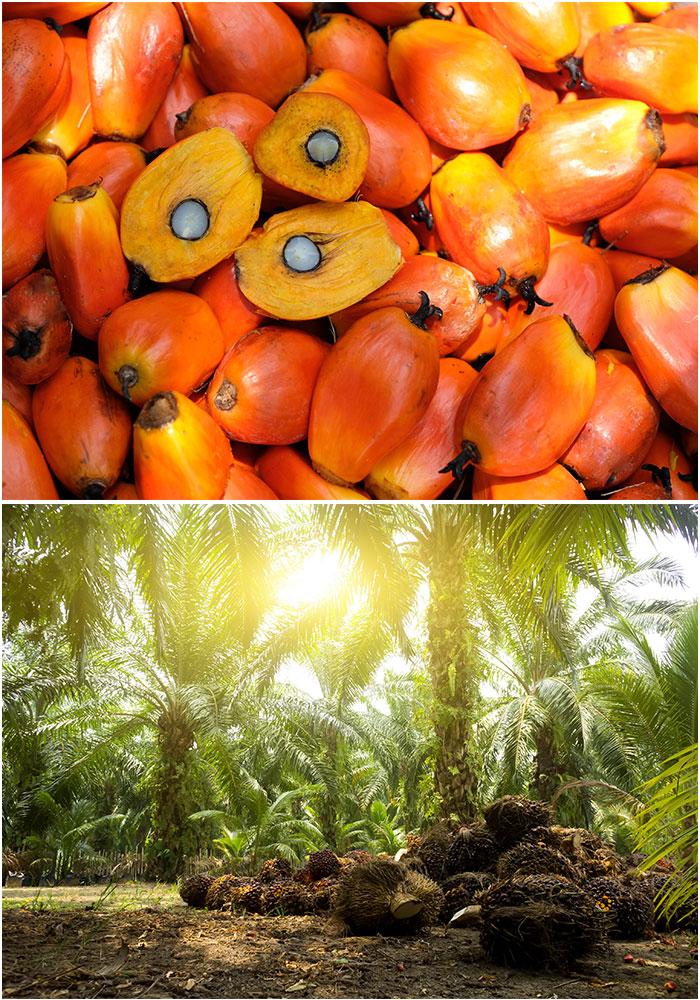
Palm oil is a type of vegetable oil that is derived from the fleshy fruit of the oil palm tree and is the most widely used vegetable oil in the world. Surprisingly, palm oil is more common than you think as it can be found in half of all supermarket products, including many processed foods, toiletries, cosmetics and candles. We'll talk about this in more detail as we go on…
You are more than likely to find palm oil plantations across continents such as Africa, Asia and the Americas, but the two main areas for the highest production are in fact, Indonesia and Malaysia. The two together account for 85% of the world's palm oil production alone and according to rainforest-rescue.org, oil palm plantations currently cover more than 27 million hectares of the Earth's surface.
Warm, humid climates offer the best conditions for oil palms to grow as they require plenty of water, causing them to thrive perfectly in these types of environments.
The volume in which palm oil is being produced (worldwide) has been on the rise since last year. As in 2016/17, the global production volume of palm oil hit its lowest at 52.32 million metric tonnes (MMT) but in 2017/18 it was recorded at 66.86 MMT - the highest production volume since 2012 (statista.com).
HOW IS PALM OIL PRODUCTION BAD FOR THE ENVIRONMENT?
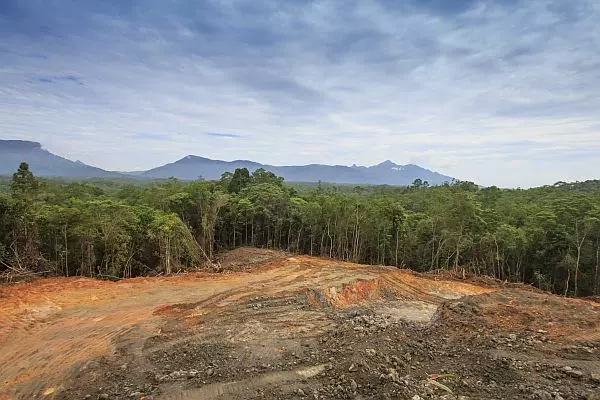
With the ever-increasing demand for palm oil on the rise and no sign of production rates slowing down, we take a look into why palm oil is so detrimental to the environment and the air that we breathe.
As you may already be aware, in order to cultivate and plant oil palms you must of course clear space to do so – which sadly means the inevitable destruction of our beloved rainforests. But what you may not realise is the extent of damage that is being done and the devastating effect it has on places like Indonesia, Malaysia and parts of Africa.
Palm oil production is the largest cause of deforestation worldwide, and while the majority of plantations are cultivated on peatlands, huge areas of rainforest are being bulldozed and torched to make room for more plantations. It is estimated that worldwide, an area of rainforest the size of 300 football pitches is cleared every hour. In light of this, Indonesia and Malaysia alone could potentially see the complete eradication of their rainforests in just a matter of years. Regardless of this fact, Indonesia has already announced plans to double its palm oil production by the year 2020 – according to the Union of Concerned Scientists.
When these tropical forests are scorched, the smoke from the fires release seemingly infinite amounts of carbon (CO2) and greenhouse gases into the atmosphere and therefore contribute significantly to pollution and climate change. It is estimated that deforestation is responsible for up to 20% of global warming.
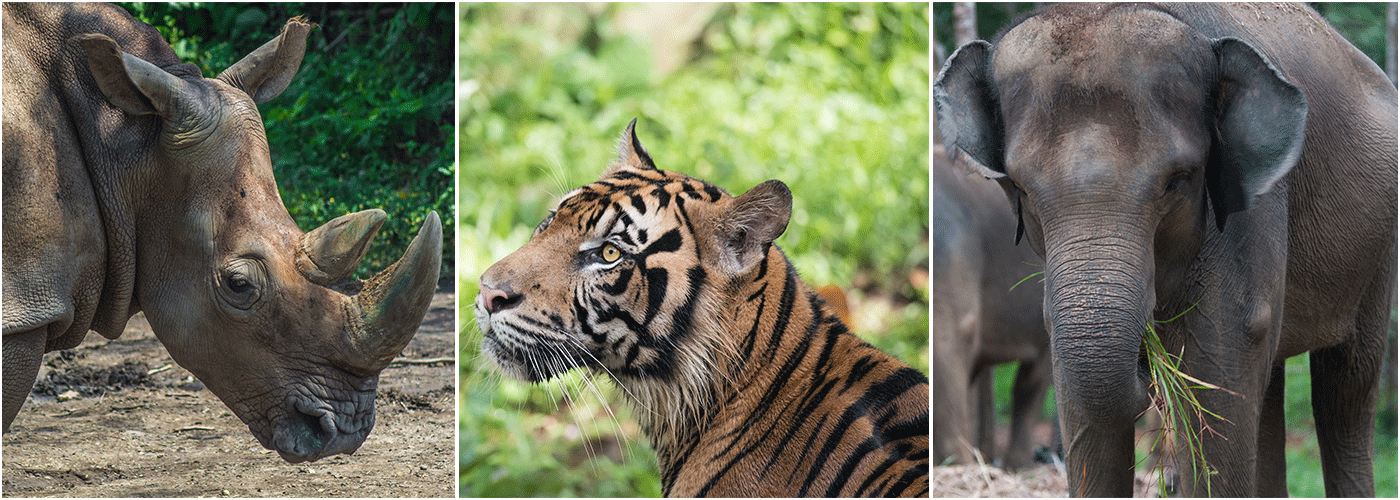
Whilst large areas of tropical forests are slashed and burned ready for new oil palms to be planted, the very real and horrible truth is that it is destroying habitats for many vulnerable species that live in these parts of the world. Indonesia's rainforests, for example, are among the world's most species-rich environments and are home to a vast array of endangered plants and iconic wildlife such as orangutans, Sumatran tigers, elephants and rhinos. Sadly, all of these animals are at serious risk and if nothing is done soon, we could, in fact, face an irreversible loss of biological diversity. And while most of these species cannot be found anywhere else in the world, only about 15% of them can actually survive in oil palm plantations.
HOW DOES PALM OIL AFFECT ORANGUTAN POPULATIONS?
Though many animals are vulnerable as a result of deforestation, the most symbolic of them all is the orangutan. It is estimated that over 50 orangutans are killed every single week due to deforestation and habitat loss. Quite often their forest homes are destroyed by the use of heavy machinery or are set alight. As a result of this, the orangutans are usually left starved with no source of food or are forced to wander into dangerous and isolated areas within plantations in search of food and water, which in turn makes them vulnerable to poachers.
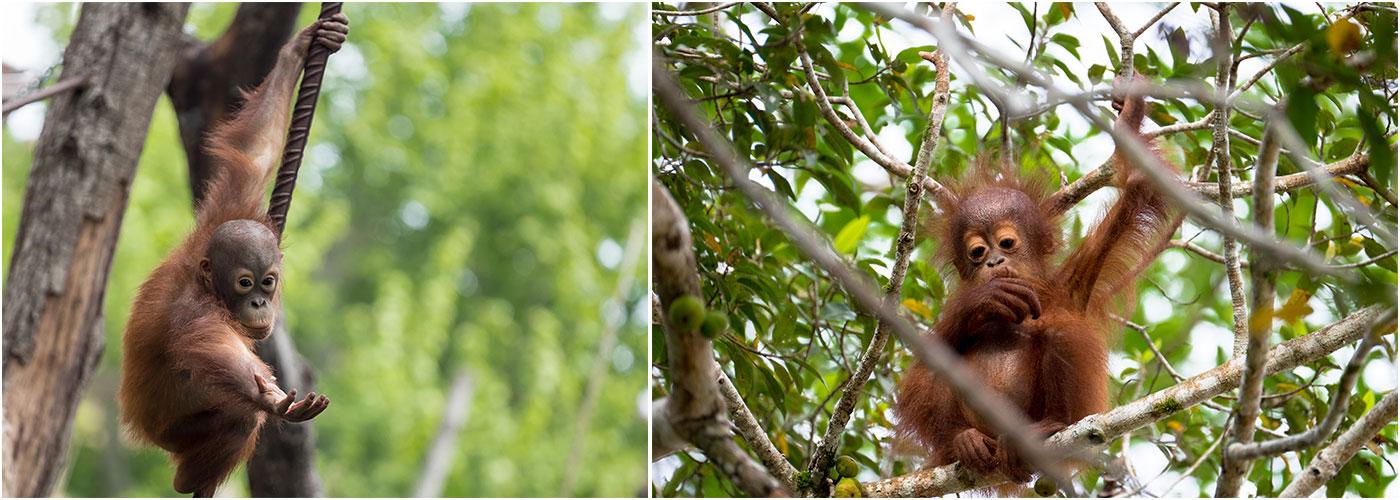
Sadly, many oil palm companies consider the orangutan as a pest as they often tend to destroy young palm plants in the hope of finding food. According to COP (Centre For Orangutan Protection), “Orangutans' poaching is done deliberately as a policy made by palm oil corporations.” These corporations hire local people as pest control, effectively, who then serve the corporation by killing any wild animals, including orangutans, who spoil oil palm trees within the plantations. These people will stop at nothing to prove their worth as they will often bring forward an orangutans' (chopped off) hand to show the corporation that they have adhered to their request and successfully killed the orangutan or wild animal. Even if these hired locals find an adult female orangutan with her baby, they will usually slaughter the mother and take away the baby to sell into the illegal pet trade. Aside for the orangutans' inevitable death by the paid locals, they are also at risk of being killed by excavation equipment, being captured and tortured, beaten, shot with guns and even doused in petrol and burnt alive.
Whilst both poaching and organised slaughter are major contributors to the decline in orangutan populations, so are forest fires. As mentioned earlier, in order to clear space for oil palms to grow, palm oil corporations instruct for the draining and burning of peat forests. In 1997/98, the drainage of such forest contributed to uncontrollable fires in Kalimantan, which, unbelievably lasted for 6 months killing up to 8,000 orangutans in the process.
Around 100,000 orangutans were lost between 1999 and 2015 and although once widely distributed across most of South-East Asia (roaming as far north as southern China and as far south as the Indonesian island of Java), today these great apes are confined to just two islands: Borneo and Sumatra. WWF explain since the orangutans' range has decreased, so have their populations. It is estimated that almost a century ago there were around 230,000 orangutans remaining in the wild, today, 104,000 Bornean orangutans and 14,000 Sumatran orangutans remain.
Orangutans suffer massively at the hands of deforestation as their survival is totally dependent on the wellbeing of the rainforest: without a place to live and sources of food, they sadly don't stand a chance. If deforestation continues to occur at its current rate, experts such as Alan Knight, CEO of International Animal Rescue, estimate that the entire population of wild orangutans could be extinct within the next 25 years.
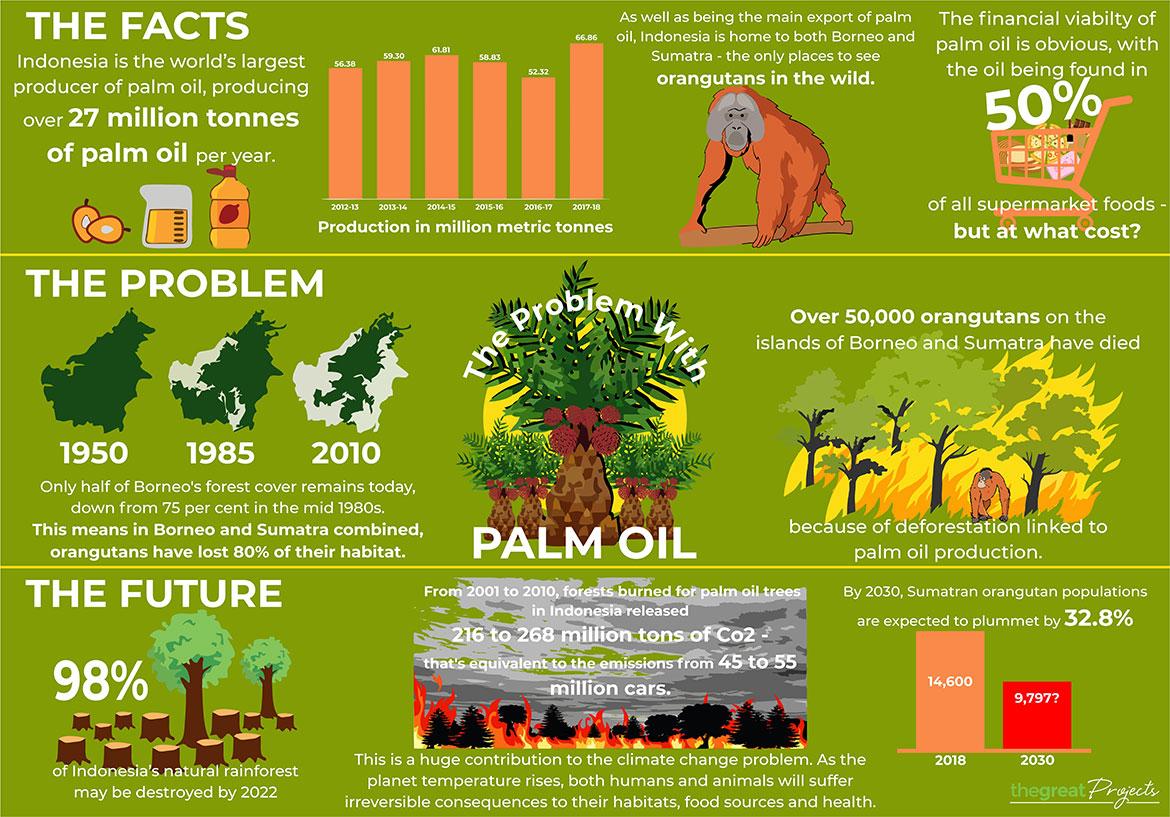
IS PALM OIL BAD FOR YOU?
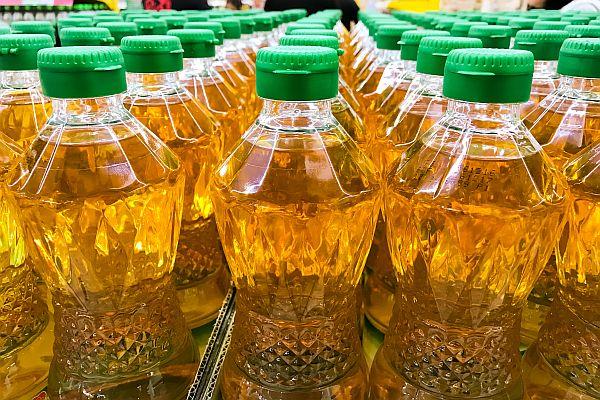
Not only is palm oil detrimental to animals and the environment, but with regards to consumer health, it isn't all that great for you either. Palm oil is high in saturated fats, and just one tablespoon contains a third of the recommended daily intake of saturated fat. While palm oil is better consumed in fresh form, the majority is generally consumed in an oxidized (processed) form. Oxidation is a refining process which increases its palatability for culinary use - this usually occurs when the fresh form is subjected to extreme heating at various time intervals. However, almost all palm oil on the market is heavily refined and as a result, nutrients and vitamins that would have naturally occurred in the oil, are lost through oxidation. As palm oil is high in saturated fat, oxidized and heavily refined palm oil presents even greater health risks to the human body.
Oxidized palm oil – often used in many baked goods, snacks or when frying food - generates toxins that adversely affect vital organs including the liver, lungs, kidneys and heart. Palm oil can reduce the effectiveness of medicines that are designed to reduce blood clotting, such as warfarin and enoxaparin. Aside from the threats mentioned, the consumption of palm oil could also potentially increase blood cholesterol levels as well as raise high blood pressure.
So, on your next journey to the kitchen, why not stop and consider what you are about to eat before you butter that slice of bread or grab that chocolate bar that you so desperately fancy…
WHY IS PALM OIL SO POPULAR?
Palm oil has become increasingly popular over the years as a result of its high-yielding, low-cost and versatile qualities. After the early 20th century, palm oil soon became a favourable choice among many manufacturers as it was made widely available and had cheap production costs across South-East Asia.
In addition to this, palm oil is generally preferred because it has many diverse uses and has the ability to be processed to form a wide range of products – palm oil has different melting points and consistencies making it a desirable oil. Palm oil has a smooth and creamy texture and is effectively odourless, making it a perfect ingredient in many recipes.
Oil palm trees are favoured because they are harvested all year round and on average they produce 10 tonnes of fruit per hectare – which is more than any other crop, including soya, rapeseed and sunflower. While the majority of palm oil is primarily used by Asian countries, the demand in Western Nations remains consistent and has boomed in recent decades. With no sign of the demand slowing down, the global production of palm oil is set to double again by 2020.
WHAT IS PALM OIL USED FOR AND WHAT PRODUCTS CONTAIN PALM OIL?
With palm oil more popular than ever and demand booming, we look into what palm oil is commonly used for including the everyday products which contain the ingredient. So, while you may not necessarily cook with it, we can almost certainly guarantee you've used it...
The European Palm Oil Alliance explain, only one quarter of palm oil and palm kernel oil worldwide is used as crude oil – also known as red palm oil, this type of oil is extracted from the pulp of the fruit of oil palms and is usually red/orange in colour – while areas such as South-East Asia, Africa and parts of Brazil tend to use the oil for domestic cooking. Europe and the United States of America, however, generally use palm oil in its refined form – also known as RBD palm oil, this type of oil is odourless, filtered and refined and is usually pale yellow in colour.
As mentioned, palm oil is the most widely utilised vegetable oil on the planet and is in at least half of all packaged products sold in the supermarket, ranging from biscuits and snack food through to cosmetics.
According to WWF, you can expect to find palm oil in cosmetics such as lipstick, shampoo and soap, as well as in foods such as pizza dough, instant noodles, ice cream, chocolate and cookies. Check out the images on the slide below to learn the reasons why these popular products contain palm oil.
There are many reasons why palm oil is used in such a wide variety of products, but how can you tell if the product you are using contains palm oil ingredients? Most people will not often think to check the ingredients on a packet before purchasing goods or applying their makeup, but even if you did, would you know exactly what to look out for? Not all products list “palm oil” on their packaging, making it relatively difficult to identify which products do contain palm oil and which do not.
Don't worry though, as we've got you covered. With over 200 different names for palm oil we understand it can get rather confusing, so we've put together a partial list of the most common names you can expect to see palm oil listed under. You can see the full A-Z of alternative names for palm oil here but for now, take a look at the list below to see if you recognize any familiar names:-
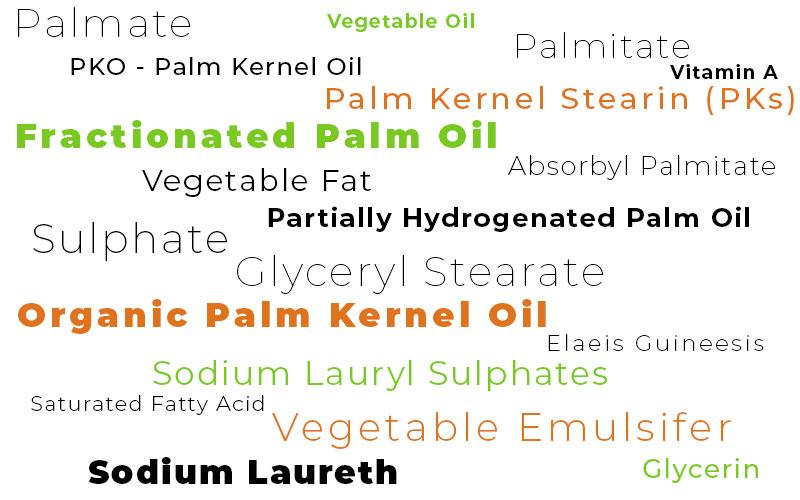
IS THERE SUSTAINABLE PALM OIL?
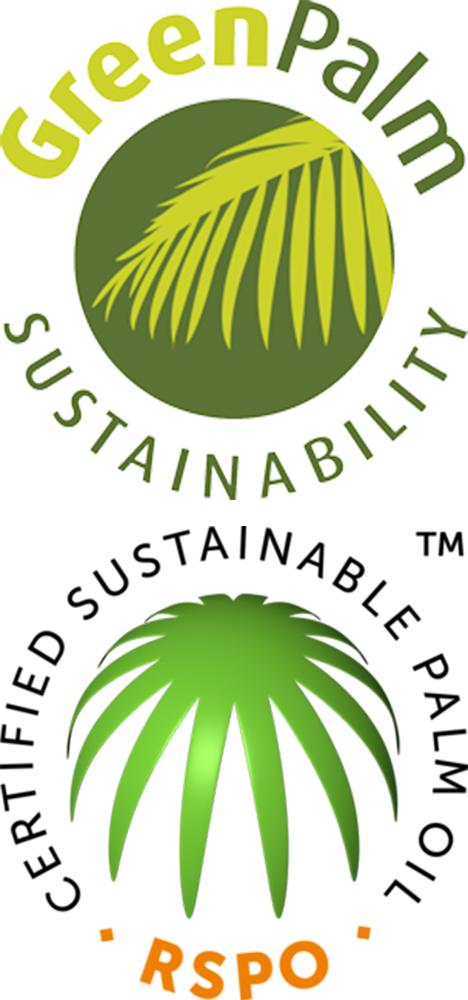
The short answer is yes – but there is still a lot more that needs to be done to ensure all palm oil is sustainably produced and is certified. Although large corporations are “slashing and burning” tropical forests to cultivate oil palms, there are more appropriate ways to produce palm oil without having to destroy the environment and its inhabitants.
Presenting…the Roundtable on Sustainable Palm Oil (RSPO). Established in 2004, it originated with the aim to certify companies and small-holders (farmers who provide their own source of income by growing oil palms in an area that is 50 hectares or less) that work towards producing palm oil in a way that doesn't harm people or the environment. Their principles are to promote the growth and use of sustainable palm products as well as to ensure that no forests or areas that contain endangered species or fragile ecosystems are to be cleared. RSPO has also stipulated that the use of pesticides and fires are to be significantly reduced and ensure workers are to be treated fairly, according to local and international labour rights standards. Along with the above-mentioned principles, RSPO has stated that local communities will also be informed and consulted before any new plantations are developed on their land. You can find out more about RSPO, their principles and how they operate here.
However, while RSPO is heading in the right direction and is doing all that they can to promote the need for sustainable palm oil, these practices will only succeed if consumers are willing to support it. Companies and businesses must take the first step towards sustainable palm oil instead of waiting for consumer demand. However, if businesses fail to do this, consumers will lose their trust, the demand for palm oil will decline and large companies will have no choice but to take action. As the world turns to a more ethical approach, businesses must be receptive to sustainable palm oil if they wish to remain profitable.
Wheatley, the Sustainable Development Manager for Marks and Spencer, says: “Making sure social and economic development doesn't cause irreversible deforestation is one of the great challenges of our time and in future years business will be held to account for their contribution. So, the risk of inaction may seem small now, but if you want your brand to grow in the future you have to be proactive, not reactive. Brand trust is hard to build but easy to lose!”.
If you would like to do your bit by using sustainable palm oil products, keep an eye out for the RSPO or Green Palm logo when you next make a purchase. The Green Palm logo means that the product supports the transition to sustainable palm oil.
One supermarket making it easy for you are Iceland, who have committed to remove palm oil from all of their branded products by the end of 2018.
Below, you can also take a look at their banned 2018 Christmas TV advert: Rang-tan's Story, which highlights the impact of deforestation on the population of orangutans in Borneo.
WHAT ALTERNATIVES ARE THERE TO PALM OIL?
So, you've discovered the everyday products that contain palm oil, touched on sustainability and even looked at the many disguised palm oil names, but now you want to know if there are any suitable alternatives to this oil.
Finding an inexpensive and less harmful alternative to palm oil may prove more difficult than you think. While palm oil is dominating the vegetable oil market, we consider whether alternatives such as soya, rapeseed and sunflower can replace this popular oil with as little impact as possible.
Interestingly, palm oil producers are quick to point out the commercial limitations of such alternatives as per hectare, a palm oil plantation averages around 3.6 tonnes of oil. On the other hand, a hectare planted with soya or rapeseed produces only 0.3 tonnes and 0.8 tonnes respectively, which in effect means that swapping palm oil for rapeseed would result in more than quadrupling the land currently occupied by palm plantations. In addition, planting such alternatives considerably increases the chemical and energy inputs required, for example, soya typically uses 344kg of nitrogen fertiliser, pesticides and herbicides to produce just one tonne of oil – whereas palm oil averages its use to 49kg. So, not only does finding a suitable alternative require heavy research and financial support, it must also meet vital demands for end users and buyers by being affordable, sustainably produced as well as healthy to consumers. While using other types of oil may seem like an appropriate solution, it would in effect create similar – if not more drastic – environmental and social problems.
In the meantime, while the search for finding a suitable alternative in palm oil production continues, the Evening Standard have since been able to find 8 palm oil free products (alternatives to your everyday favourites) that you can try!
While boycotting palm oil altogether is probably a tough move, you can still enjoy palm oil products responsibly and sustainably by either looking out for the Green Palm or RSPO logo on the products, by checking out the 9 palm-oil free products above or if you choose, avoiding products that contain the oil altogether. So, before you fill up your shopping basket and make your next purchase, we urge you to consider. Take a moment to stop and think about how that particular product was produced, including the path it may have taken to reach the supermarket shelf. Think about how many innocent animals may have been injured or killed in the production of that product. Imagine, just for a second, the overwhelmingly large scale of forests that were (and still are now) destroyed in the process. And all for what...?
Sources:
www.palmoilinvestigations.org/about-palm-oil.html
https://inews.co.uk/news/environment/what-is-palm-oil-why-so-bad/
https://ndb.nal.usda.gov/ndb/foods/show/04055
https://www.sciencedirect.com/science/article/pii/S231485351500030X
https://healthyeating.sfgate.com/palm-oil-health-hazards-7375.html
https://greenpalm.org/about-palm-oil/why-is-palm-oil-important
www.theguardian.com/sustainable-business/ng-interactive/2014/nov/10/palm-oil-rainforest-cupboard-interactive
https://www.theguardian.com/sustainable-business/2014/nov/26/10-things-you-need-to-know-about-sustainable-palm-oil
